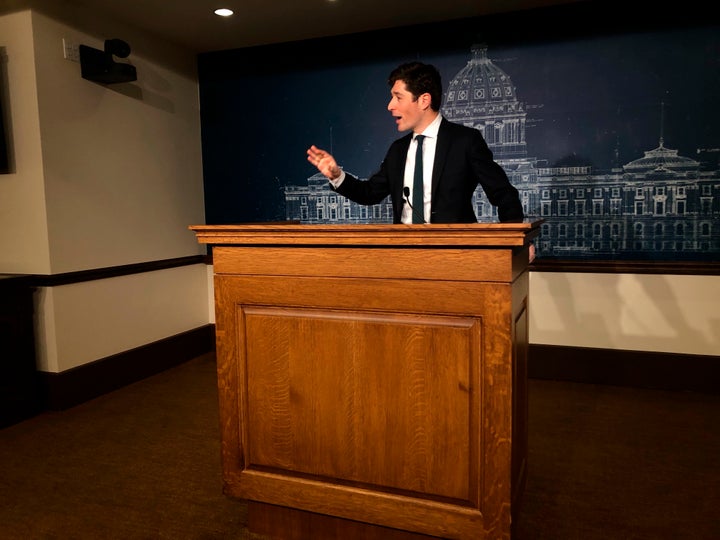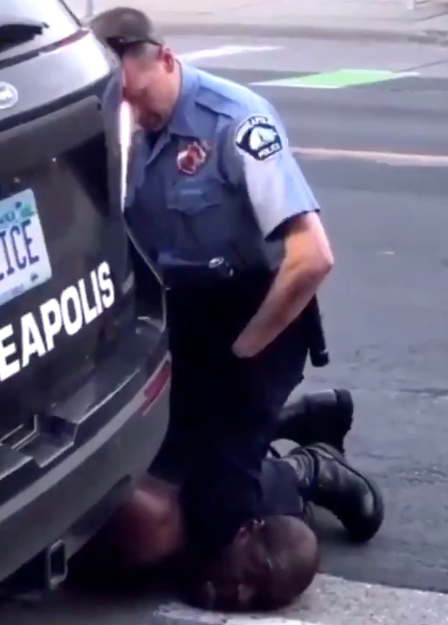
The FBI is investigating a Black man’s death after bystander video recorded Monday showed a Minneapolis police officer pressing his knee into the handcuffed man’s neck as he shouted that he couldn’t breathe.
Police did not immediately authenticate the video, but Minneapolis Mayor Jacob Frey said Tuesday that he believed what he saw in the clip and characterized the officer’s actions as “wrong on every level.”
The bystander video, which has been widely circulated on social media, shows the officer, who appears to be white, pinning the man face-down on the street.
Attorney Ben Crump identified the man as George Floyd after announcing he had been retained by Floyd’s family to represent them.
In the clip, Floyd is heard pleading with the officer.
“Please, man, I can’t breathe,” he says.
Floyd repeats the phrase again and again: “I cannot breathe. I cannot breathe.”
Within minutes, he closes his eyes and stops speaking. The officer appears to keep his knee on Floyd’s neck, even as onlookers begin shouting for police to attend to him. A second officer is shown nearby, looking in the direction of onlookers.
“Get off of him!” one woman is heard shouting.
“Bro, he’s not fucking moving!” another bystander shouts. “Get off of his neck!”
(Note: A still image from early in the video, before Floyd stops moving, appears below.)

Officers called for an ambulance but Floyd died shortly after arriving at a hospital, the Minneapolis Police Department said in a press release. Police did not release his identity at the time but said they believed he was in his 40s.
The two officers had arrived at the scene in response to a reported “forgery in progress,” the police statement said. The suspect, police said, was in a car and appeared to be under the influence. He “physically resisted” officers, police said.
“Officers were able to get the suspect into handcuffs and noted he appeared to be suffering medical distress,” the statement said.
The press release stated that no weapons were used during the encounter. It did not mention that an officer had pinned Floyd to the street and had put his knee on Floyd’s neck prior to his death.
The police department said an investigation was underway. The Minnesota Bureau of Criminal Apprehension and the FBI would be included, police noted without elaboration.
The Bureau of Criminal Apprehension said in a statement that it will present its findings without recommendation to the Hennepin County Attorney’s Office for review. The agency said it would share its findings with the FBI, which is conducting a separate federal civil rights investigation.
The FBI did not immediately respond to HuffPost’s request for comment.
Video recorded by officers’ body cameras, which were turned on during the encounter, is being reviewed as part of the investigation, police said.
Police Chief Medaria Arradondo announced the firing of four Minneapolis officers during a news conference about the incident on Tuesday. He did not publicly identify the officers.
“He should not have died,” Mayor Frey said Tuesday. “What we saw was horrible, completely and utterly messed up. ... Whatever the investigation reveals, it does not change the simple truth that he should be with us this morning.”
“Being Black in America should not be a death sentence,” Frey continued. “When you hear someone calling for help, you are supposed to help. This officer failed in the most basic human sense.”
A protest against police violence has been planned for Tuesday night at the intersection where the incident occurred. Frey said he supported the right of community members to express their anger, but encouraged protesters to social distance and wear masks to prevent the spread of the coronavirus.
Social media users noted similarities between Floyd’s death and that of Eric Garner, an unarmed Black man who died in 2014 after being placed in a chokehold by a New York City police officer.
“I can’t breathe,” Garner said repeatedly before he died.
The Minneapolis Police Department has faced intense scrutiny from community members over incidents of police violence in recent years. In 2015, protests erupted after an officer fatally shot 24-year-old Jamar Clark in the head during a confrontation. The following year, an officer was fired for threatening to break a Black teenager’s legs during a traffic stop.
In 2017, Janeé Harteau resigned as the city’s police chief about a week after Justine Damond was shot to death outside her home by a police officer.
This story has been updated.